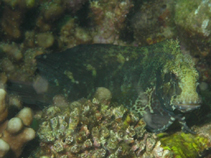| Family: |
Blenniidae (Combtooth blennies), subfamily: Salariinae |
| Max. size: |
13 cm TL (male/unsexed) |
| Environment: |
demersal; marine; depth range 0 - 6 m |
| Distribution: |
Western Central Pacific: Philippines. |
| Diagnosis: |
Dorsal spines (total): 12-12; Dorsal soft rays (total): 18-21; Anal spines: 2-2; Anal soft rays: 19-21. Generally uniformly dark brownish, lacking spots on pectoral and caudal fins; Dorsal rays typically 19-20; anal rays typically 20; pectoral rays typically 15; segmented caudal rays 12-13, branched middle nine; nasal, supraorbital, and nape cirri branched or fringed with filaments; upper and lower lip margins smooth; occipital crest absent; last anal ray and caudal peduncle connected by membrane; body somewhat deep, depth at anal-fin origin 3.0-3.3 in SL (Ref. 90102). |
| Biology: |
Adults are found in sheltered shoreline reefs, often in turbid water. They are found solitary or on live and dead coral (Ref. 90102). Oviparous. Eggs are demersal and adhesive (Ref. 205), and are attached to the substrate via a filamentous, adhesive pad or pedestal (Ref. 94114). Larvae are planktonic, often found in shallow, coastal waters (Ref. 94114). |
| IUCN Red List Status: |
Least Concern (LC); Date assessed: 27 March 2009 Ref. (130435)
|
| Threat to humans: |
harmless |
| Country info: |
|
Source and more info: www.fishbase.org. For personal, classroom, and other internal use only. Not for publication.

